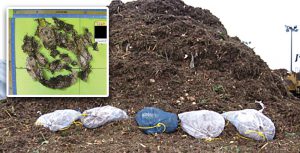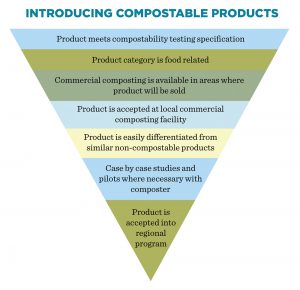
Michele Riggs
BioCycle June 2015
The ability to compost locally is a valuable resource to sustainable communities environmentally and economically, naturally spurring collaboration, innovation and product development. The use of compostable food service products in regional organics recycling programs can increase the amount of organic residuals that can be captured from the waste stream and transformed into a beneficial soil amendment used in multiple applications. The most successful composting programs are the result of significant endeavors and collaborations between stakeholders. These stakeholders include processors, compostable product manufacturers, haulers, government and related private industries such as retailers and businesses.

Collaboration between the compostable product manufacturer and the composting facility begins with ensuring that the product disintegrates within the specified composting technology. Testing products for compostability — example of stages of disintegration testing at Cedar Grove Composting — is illustrated. Photos courtesy of Cedar Grove Composting
When it comes to adding compostable foodservice ware to organics recycling programs, product manufacturers must engage first (not last) with composters in a new product launch into a region for practical and economic reasons. Packaging manufacturers expend vast resources to find the right substrate formulation for optimal consumer performance while balancing the ability to biodegrade and disintegrate at a composting facility. If that is accomplished — and regional processing options are available to design a diversion system — then additional resources can be expended in education and outreach programs that help with a successful launch and ultimately can sustain something that works for the entire supply chain. This supply chain network can also find solutions if problems occur.
Compostable packaging began as a solution to facilitate capture of additional valuable food feedstocks for composting facilities. This in turn helps raise the recycling rates in municipalities, which are often driven by aggressive zero waste polices. As the use of and interest in compostable products within a region rises, so does the need for new products to be developed. Many compostable foodservice ware manufacturers understand the need for collaboration and what is involved to integrate a new product into an organics recycling program. Occasionally, the cart does get before the horse, or someone brand new to this “compostables” world begins a race to get products to market before they are successfully vetted among stakeholders. Ambitiously, a product is launched and pushed out to the supply chain and on retail shelves without the necessary research to ensure that the product will not increase contamination in incoming compost feedstocks and ultimately in the composter’s finished product.
It is important that manufacturers communicate and work with composters to ensure that product development follows best practices and that the end products are truly compostable. What are best practices? Before any product is sold or even marketed as compostable, it must meet at least one of the recognized standards for compostability, i.e., ASTM D6400, D6868, or EN13432, or any equivalent specification. These benchmarks ensure that if these products are introduced as composting feedstocks, they will biodegrade and cause no detrimental effect to the finished compost.
Understanding The Process
There are many parameters and hurdles to meet compostability standards, and it is equally important that the manufacturer ensures its product will be welcomed into the intended commercial composting facility for which the product is designed to disintegrate. As stated, this is where collaboration between the product developer and the composter should begin. While a product may be compostable, and disintegrate within the specified composting technology for that region, there are issues beyond its compostability to consider. For instance, is the composter’s product registered as organic for use in organic agriculture? If so, acceptance of compostable products will void a composter’s registration.
Will consumers get confused? If a manufacturer develops compostable chip bags or water bottles, is there a risk that consumers will start to think that all chip bags and water bottles are compostable? This can and does happen; just ask any commercial compost manufacturer. With collaboration, research and compromise, it is possible to minimize the potential for “comealongs” or “lookalikes” which ruin good feedstock streams.
Recycling programs only work if the recycled product being generated or created can sustain a viable business model. There must be an end use for the product, and the ability to be sold for profit. Just as food packaging companies must ensure that their incoming feedstocks are pure and clean, so must a company or municipality that manufactures compost. If a composter’s feedstock is inundated with plastics or packaging with fraudulent product claims, which confuse the consumer and the composter, the composter is often left holding the bag (pun totally intended). This dramatically drives up labor, disposal and processing costs, and puts successful composting programs in economic jeopardy. What’s at stake? Vital composting infrastructure and communities at risk of losing their composter, which means all the effort and resources used to create, vet and conduct consumer outreach for compostable products would ultimately be wasted.
As stated previously, many stakeholders understand why all of these factors are important for successfully advancing food scrap recycling. Yet there are many entities in all stakeholder industries that do not understand what it takes. The steps outlined in Figure 1 illustrate the progression that needs to be followed when introducing a compostable product into a regional composting program. First and foremost is that the product meets the established compostability testing standards and it is within a food-related product category. The steps in between ultimately lead to a product’s acceptance into a composting program.
Therefore, moving forward as a “compostable industry,” it is important for those who understand to educate those that don’t on the how’s and why’s so sustainable organics recycling can continue to grow and the resulting production and application of high quality compost can continue. Without proper education and scientific vetting of new products, compost won’t go back to nature … it will be too full of plastic.
Michele Riggs, the Environmental Technician at Cedar Grove, oversees all field testing of compostable products. Her pioneering work includes developing science-based protocols for determining “compostability” for products within active composting processes. She also serves on the Board of Directors as the Vice President of the Washington Organic Recycling Council.














